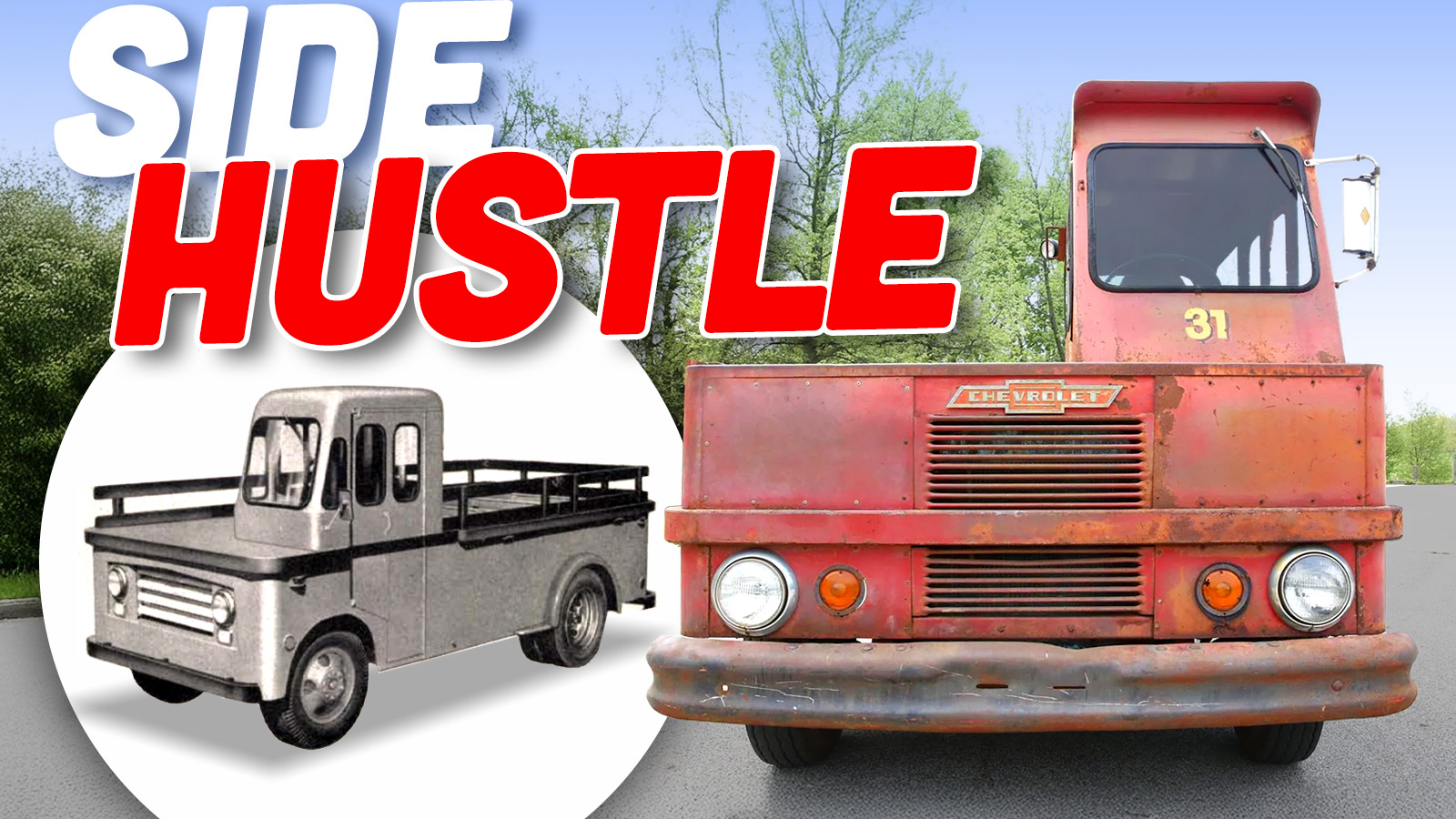The delivery truck is an unsung hero of modern society. Life just wouldn’t be the same without being able to have goods delivered to the home or the jobsite. One kind of truck most people likely don’t think much about is the lumber truck. When you order lumber, a large flatbed truck rolls to your jobsite and delivers the goods. These trucks tend to be huge, but it wasn’t always this way. Several decades ago, one Illinois company tried to reinvent the way lumber is delivered by making trucks that were nothing but flat decks. This is the DeKalb Lumberjack, and it’s a truck shorter than a modern minivan, yet it carries larger loads than any pickup truck on the road today.
The DeKalb Lumberjack and its derivatives are types of trucks that are known as vocational trucks. In short, a vocational truck is one designed to be really good at a specific job. Fire engines, dump trucks, bucket trucks, garbage trucks, tow trucks, crane trucks, food trucks, and concrete trucks are all great examples of vocational rigs. Sure, these trucks could be used in other roles. You can park a car in a dump truck. However, these trucks are really meant to be really good at a specific job.
The DeKalb Commercial Body Company of DeKalb, Illinois, specialized in vocational truck bodies. The company used to take commercial chassis and build special bodies for deliveries of milk, bread, refrigerated goods, furniture, and more. In 1955, the company launched a new product aimed at the lumberman. The DeKalb Lumberjack sought to make lumber deliveries faster and more economically by making a truck that was all about lumber. The Lumberjack was little more than a giant bed for lumber with an engine and four wheels, plus a tiny place for a driver to operate the thing. In creating the Lumberjack, DeKalb created one of the weirdest work trucks.

Born In The Midwest
According to the business history site Coachbuilt.com, the DeKalb Commercial Body Company opened for business in 1904 as the Sycamore Wagon Works of Sycamore, Illinois. This is backed up by a report written in 1904 by the True Republican newspaper of Sycamore. That report details how Charles E. Bradt, Samuel E. Bradt, and Madison D. Shipman joined forces to build their own patented delivery wagons. The men raised $5,000 to secure a facility in Sycamore, Illinois, and the report said that Sycamore Wagon planned to build wagons for milk and piano delivery.
According to Coachbuilt, the Bradts had experience in manufacturing and selling gloves. Meanwhile, Shipman was a physician. Their Sycamore Wagon Works first specialized in lightweight, highly maneuverable horse-drawn wagons. Sycamore Wagon also advertised its Sycamore One-Step Wagon, a design for a low-floor wagon for easy ingress and egress.

As time progressed, Sycamore Wagon’s business evolved from delivery wagons to early vocational trucks, and with it, the company’s name changed with the times, too. In 1912, the company changed its name to the DeKalb Wagon Company and further expanded its work truck business with the purchase of the assets of the defunct Randolph Motor Truck Co. of Flint, Michigan.
In 1940, the DeKalb Centennial Committee writes, the company changed its name one more time to the DeKalb Commercial Body Company, reflecting DeKalb’s commitment to building work trucks. By this time, DeKalb had built a wide variety of trucks from fire trucks to refrigerator trucks, alongside low-floor delivery vans.
It was also around this time that DeKalb launched a research department. Members of this department would visit tradesmen in the field and learn about what they loved and hated about their trucks.
The Lumberjack

In 1955, DeKalb began advertising a new kind of truck. According to advertisements, DeKalb engineers met with members of the lumber delivery industry to find out what they wanted in a truck. DeKalb found out that lumbermen wanted a truck that made it easy and economical to deliver a “jag” (load) of lumber. Existing trucks were large, not particularly maneuverable, and were expensive to operate.
DeKalb’s solution was to develop a truck that could carry a full load of lumber that would normally require a large truck, but in a compact footprint. This truck was called the DeKalb Lumberjack, and the DeKalb’s custom body was bolted to existing Dodge, Ford, and International Harvester commercial chassis.

How this worked was pretty clever. Normally, the front end of a truck featured the engine and the cab. Behind that sat the cargo area. More compact trucks were built as cab-over-engine designs, where the cab was piled on top of the engine and front axle. Both of these designs have a limitation where the carried cargo cannot take up the full length of the vehicle since the engine and cab are in the way.
The DeKalb Lumberjack features a body that’s primarily just a flatbed surface. This flatbed sits at just a touch above engine level, allowing for a perfectly flat load floor. As photos show, this surface ran the entire length of the truck and featured open ends, allowing for the transportation of lumber that was longer than the vehicle itself.
A critical element of the Lumberjack was what DeKalb called the “half-cab,” a little pod that’s just barely large enough for the truck’s sole occupant, its driver. This is a concept that has been used many times throughout history in large commercial trucks, including mobile cranes, dump trucks, mixer trucks, and more. Automotive visionary Preston Tucker had also sketched out something similar to the design of the Lumberjack back in the 1940s.


The original Lumberjack had some dead space under the load floor, and DeKalb offered an option to install cabinets in the lower portion of the body to haul tools, paint, nails, or other work equipment. In addition, there was another load space directly under the main floor for the loading of other building materials like plywood, insulation board, and other materials that weren’t very long.
An early Lumberjack measured about 16 feet long. That’s a foot and a half shorter than a new Ford Ranger. It’s still shorter than a Honda Odyssey. Of course, it’s also smaller than a modern full-size pickup and practically minuscule compared to a new heavy-duty pickup truck. Yet, because of its unique design, it was capable of carrying 18-foot-long lumber in addition to plywood, drywall, and other building materials.


According to DeKalb’s The Daily Chronicle, local lumber yards were in love. The newspaper said that local yards usually had to operate trucks with 160-inch wheelbases to haul what the DeKalb Lumberjack could carry with only 125 inches of wheelbase. DeKalb’s truck promised easier and faster loading on top of cheaper operating costs, thanks to the truck just being smaller and lighter. Lumberjack trucks also rode on common platforms, so repairing them wasn’t any different than usual.
In 1956, the California Lumber Merchant writes, DeKalb announced an evolution of the Lumberjack with the Lumberjack Sr. This truck had the same 16-foot length and 122-inch to 126-inch wheelbase, but dual rear wheels and an upgraded carrying capacity. DeKalb marketed its truck as being 9 feet shorter than a typical lumber delivery truck.

Apparently, lumber yards around Illinois and Wisconsin loved these trucks and demanded even more from DeKalb. The company responded in 1958 with the DeKalb Lumber King. This truck was similar to the Lumberjack, but stretched to 21 feet long on a 149-inch to 157-inch wheelbase. The Lumber King also featured a stake bed and rollers, which allowed for cargo to roll on and off the truck. An alternative version of this truck, the Steel King, was targeted at the steel industry.
You might be wondering why DeKalb quotes such huge ranges for wheelbase lengths, and this was because DeKalb was a body constructor. You provided the truck. DeKalb wanted to sell these to basically any business that wanted one, so that meant offering these bodies for basically any domestic brand of forward control truck.

DeKalb would also expand outside of delivery trades. There was also the DeKalb Contractor, a Lumberjack with bed rails and additional tool space. Then there was the DeKalb Journeyman, and it was designed for plumbing, HVAC, and similar trades. This one also had bed rails and several toolboxes. DeKalb did note that it was not the only company with this weird flatbed pickup truck concept, but claimed that such an idea was still rare in America.
In case you’re curious, these trucks were ridiculously basic inside. Forget about niceties like a radio or an air-conditioner. These things didn’t even have headliners! But hey, these trucks didn’t really need to be pretty, they just needed to get work done.


I do not have any production data on hand, but these trucks are considered to be very rare. An Internet search for these trucks yields only two in the modern day. One of them sold on Bring a Trailer for $19,500 in 2022. That truck was a DeKalb Lumber King and was based on a Chevrolet P35 chassis.
I’ll give you an idea of the hauling power here. The P35 was often used as a step-van chassis and featured a 10,000-pound GVWR. The truck from the Bring a Trailer auction featured a 292 cubic inch straight-six. That engine would have made 153 HP net and 255 lb-ft of torque net when new. So, this isn’t a fast truck, but good enough to put some work in.
A Dead End?

Unfortunately, it’s not known how well these trucks sold. DeKalb also never mentioned prices. Coachbuilt notes that the DeKalb Commercial Body Company didn’t seem to survive the 1970s. The company was listed in the DeKalb City Directory until 1969. By 1971, DeKalb’s facility was vacant. It’s not known why DeKalb failed or exactly when, but the trail does go cold after 1969.
Of course, this truck is also sort of a dead end. Vans are superior platforms for plumbers, contractors, and HVAC technicians, and straight trucks are perfectly capable of hauling lumber.
I’d love to drive one of these trucks today. I imagine myself parking a slew of motorcycles on one. Or heck, I’d have fun just scooting around in one as a classic car. It’s like a miniature aircraft carrier on wheels. I can see why these trucks didn’t work in the long run, but it’s so cool that they existed when they did.









Probably around 2004 I saw one of these parked along a side road along my commute. I finally stopped by and took some pictures of the weird truck. I knew immediately what is was used for, but so, so cool. So long ago that finding pictures would be about impossible. It sat there for about week.
I bet it sleeps all night and works all day. If I had one, I’d take it when I go shopping on Wednesday.
In a more joyous, just world, these things would have their own racing series.
How cool! More useful than my VW favs – the single cab and DOKA. Love these deep dives on old stuff. Keep up the great work.
What a cool truck! And to learn it was built in the town I’ve lived in for ten years is even cooler. I suppose the part about piano delivery early in their ventures would have been a good idea considering the Wurlitzer plant was here also.
I’VE BEEN TALKING ABOUT SOMEONE MAKING A TRUCK LIKE THIS!
I’m glad someone went and did it.
Honestly I wish someone would make an oddball truck like this, but with a lower deck height, today.
You could have an 8ft long pickup with an 8ft long bed!
It would make the ultimate motorcycle hauler!
Perhaps you could have a 2 seater with the passenger sitting behind the driver and the cargo area along one side. 2 people, 2 bikes or whatever else. Lol
EXACTLY! I don’t need to have my passenger sitting next to me, so give it tandem seating if you want more than one seat.
I would image it would be relatively easy to do with today’s EV trucks. The F-150 Lightning, in particular, should be easy since it is body-on-frame. Granted, that would be way longer than 8 feet, but you’d have a hell of a lot of cargo bed area if you eliminated 4/5 of the seating.
That’s what I’m thinking too. Build it on a skateboard chassis, though I think an F-150 Lightning is too long to take proper advantage of the small OAL the configuration allows for.
Agreed, but does anyone make a true body-on-skate EV right now? There are plenty of smaller EVs out there but I believe that even the shared platform ones have their bodies too integrated to simply unbolt and lift-off. If they actually make it, the Slate may be a perfect candidate.
Eh, the Slate’s cab seems very integral to the chassis.
Didn’t Jason imagine trucks like these, maximizing cargo space, back at the old site?
Wouldn’t surprise me, but my version I thought of after seeing those luggage loader trucks with the conveyer belt. I’m not taking credit for the idea, just that I’ve arrived at the same idea as others yet none of us have seen them reach mass production.
I once saw one of these in person and was fascinated. It was in such poor condition I couldn’t find any manufacturer name left on it, so I had always wondered who made them. Thanks for clearing up this years old mystery for me!
No radio
No A/C
But it does come with a cigarette lighter (and probably 7 ashtrays)
If it has windows that open, the whole world is your ashtray!
Your aircraft carrier remark makes me want to get one and populate the thing with model planes and figures. What a daily driver that would be!
Paint the load deck like the flight deck on an Essex class carrier and load it up with models of Corsairs, Dauntlesses, and Wildcats with some people models running around. With the space under the load floor, you could even do an elevator on the flight deck as well. It would be the talk of every car show you took it to!
And every air show 🙂
Cool camping platform!
This makes me think of the DM series Mack trucks with the cab shoved over to the side, for things like cement mixers and dump trucks.
I really loved those when I was a kid. They are so weird looking, in a good way.
I did a tiny bit of digging and it seems the owner and president of Dekalb Commercial Body Corp stopped working there in 1969.
https://www.erhsalumni.net/class_profile.cfm?member_id=4694810
I’d guess the business failed around the same time.
This was interesting!
It’s also interesting to me how little HP these trucks, and most other large trucks from that era, actually made, and still were put to hard work and good use.
Especially compared to modern trucks that require 400hp/500lb-ft+ just to get groceries.
Probably deep low gear in the trans, deep axle ratio, and not much top speed.
Torque ftw.
Gréât article Mercedes! Now I kinda want one.
I remember there used to be lots of narrow cab trucks for hauling steel, but the steel would pass the cab on both sides to keep it balanced. Back in the 70s they were drilling lots of oil wells around here and the trucks that delivered and picked up well rod were like that. As far as I know they never found much.
I wonder, when you had a load hanging off the front, did you need one of those red flag things. Or since it’s the front, would it be yellow?
Your comment made me realise I don’t know the laws about that in the UK, turns out it’s quite straight forward:
Less than one meter overhang? Don’t need anything. 1-2m? Ends must be ‘made visible’ (ie hang a hi-vis off it). 2-3m you need actual marker boards. Finally if it’s over three meters you have to notify the police at least two days in advance and follow a whole list of regulations.
This seems to be the current primary producer – https://fontainemodification.com/work-trucks/cab-modifications/narrow-cab/
I can already envision it with Lowe’s decals down the side doing a delivery. Another great find Mercedes.
DeKalb and Sycamore are right around the corner from me and both had a lot of manufacturing back in the day. Now DK is dominated by NIU and Sycamore is just another tawny west suburb like Geneva or Glen Ellyn.
I went to law school at NIU back in the ’90s. Good times! Didn’t know about these things though – another great find from Mercedes. She does dig up the most oddball things.
An NIU grad from the ’80’s from the I & T area, did not know this history, a great article.
OK Huskies how about this?
When the State was deciding where to locate Northern, several towns were in play. On the day the committee was to visit DeKalb, the town fathers had the Kishwaukee dammed upstream of town, and then released it, along with a shit-ton of live fish, at just the right moment.
Instead of the usual slow, sluggish, nasty Kishwaukee River, the committee saw a rushing river full of life. And that’s how DK got NIU, by pulling the wool over their eyes.
The tiny cab reminds me of those ancient tiny funiculars
There are similar medium. duty trucks used for delivering steel rods and pipe since like the DeKalb the space next to the cab allows longer loads
Another interesting find and great read. I’m familiar with a lot of odd duck trucks, but I’d never encountered the Lumberjack. Thanks for broadening my horizon.